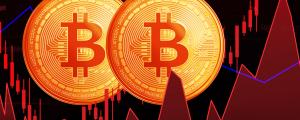Ever since the post-pandemic boom in the US stock market came to an abrupt end in late 2021, it's been an arduous slog for many companies to try and regain some of the ground lost during the slow grind lower of 2022. The start of this new year seemed to offer an olive branch to the battered stock market as major indices gained over 10% in January 2023 alone. However, by the end of July, the wheels had already begun to come off the recovery.
Since then, the country's two biggest indices — the S&P 500 and Nasdaq 100 — have both lost close to 10%, dropping from $4,576 and $15,826 to $4,193 and $14,409, respectively, in the space of just three months. But movements this week would seem to suggest there could be light at the end of the tunnel for tortured stock market investors.
The release of the latest Consumer Confidence numbers saw the S&P 500 rise 0.7% on 31 October, while the Nasdaq managed to move up 0.5%. These gains were then built upon further the next day as the Fed's decision to hold rates steady saw respective jumps of 1.1% and 1.6% for these major indices. The gains might not look like much on the face of it, but they're a sign that equity prices are responding positively to key economic data despite the ongoing (and worsening) geopolitical instability. As the world begins to interpret the Fed's latest decision and post-meeting comments, traders and investors everywhere are wondering what the implications for the stock market will be up to the end of this year and beyond.
Positive data releases surprise market
With the increasing geopolitical instability that has now spread to the Middle East, persistent inflation, and higher costs of borrowing, many would expect key economic indicators to be suffering. However, in the US, at least, the muted impact of these multiple factors has left analysts scratching their heads. While the recent Consumer Confidence figures released this week by the Conference Board were indeed down from a month ago, the decline to 102.6 from 103 in September was much less than the full three-point decline predicted by a Reuters poll of economists.
Meanwhile, the US job market appears completely unfazed by the pervasive uncertainty as it continues to defy all the odds. After adding 336,000 jobs in September, unemployment remains steady at a very healthy 3.8%. The US Labor Department's Job Openings and Labor Turnover Survey (JOLTS) also showed layoffs dropping to a nine-month low, while job openings — a key yardstick of labour demand — were up 56,000 to 9.553 million on the last day of September. Overall, the survey reported that there were 1.5 open jobs for every unemployed person in the US, which is a stark contrast to the pre-pandemic average of 1.2.
While it's not entirely clear why the labour market is performing so well at present, there's no doubt that this is a positive factor for equities that could lead to sustained growth in the near-to-medium term.
Fed feeds confidence in risk assets
In a move welcomed by investors, the US Federal Reserve decided to hold rates steady for a second consecutive month at its meeting on 1 November, similarly opting to maintain the federal funds target rate at 5.25% to 5.5%. This has been interpreted by many to mean that the US regulator is finally finished with its rate hike cycle, which is why the stock market responded so favourably to the news.
However, as is always the case with these FOMC meetings, it's the closing press commentary where we can find some of the biggest pearls of wisdom. In his post-meeting comments, for instance, Powell upgraded his assessment of the economy, saying that "economic activity expanded at a strong pace in the third quarter" compared to the "solid pace" he referred to back in September.
Ironically, it appears that the Fed policymakers think that it is precisely the strong labour market and higher-than-expected GDP growth that is keeping inflation high, with Powell stating that "we will need to see some slower growth and some softening in the labour market to fully restore price stability". Despite the latest hold on interest rates, policymakers don't seem worried about making further rate hikes if needed, even if they elect to keep rates steady for a third time in December. This all but amounts to a tacit commitment by the central bank to a more dovish policy, which is good news for stock market investors. Once the market accepts that the rate-raising cycle is truly over, money will begin to flow freely back into risk assets.
Trade the stock market with Libertex
With multi-decade experience bringing the financial markets to ordinary retail traders and investors, Libertex has become a name synonymous with reliability in the contracts for difference (CFDs) trading space. Libertex provides CFDs in a wide range of asset classes, from commodities, options and crypto to stocks, indices and ETFs. In addition to exotic indices from Asia, Latin America and the Middle East, Libertex has every one of the US's Big Three indices — the Dow Jones Industrial Average, the S&P 500 and the Nasdaq 100 — as well as tonnes of individual company stocks from all around the world. Offering both long and short positions with optional leverage, Libertex's CFD trading model allows you to potentially benefit from price changes in a given instrument without physically owning the underlying asset.





